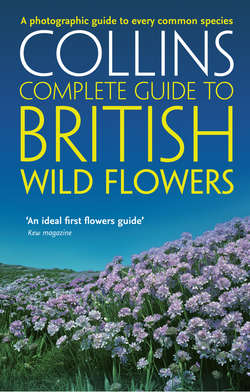Читать книгу British Wild Flowers: A photographic guide to every common species - Paul Sterry - Страница 15
Juniper to Nettle Families
ОглавлениеJuniper
Juniper Juniperus communis (Cupressaceae) HEIGHT to 5m (sometimes prostrate)
Dense shrub of well-drained soils, from chalk downland to mountains. FLOWERS On separate-sex plants; those on female plants are green and oval (much of year). FRUITS Ripening in second year to form blue-black berry-like cones. LEAVES Stiff, bluish green, needle-like, in whorls of 3. STATUS Widespread and locally common.
Hazel catkins
Hazel
Hazel Corylus avellana (Betulaceae) HEIGHT to 12m
Dense woodland shrub or small tree; often coppiced. FLOWERS Catkins (male) or small red, tufted structures (female) (Jan–Mar). FRUITS Hard-cased nuts, green, ripening brown in autumn. LEAVES Appearing after flowers, 6–8cm long, circular to oval, with double-toothed margins. STATUS Common and widespread.
Bog-myrtle
Bog-myrtle Myrica gale (Myricaceae) HEIGHT to 1m
Woody, brown-stemmed shrub that is characteristic of boggy habitats, usually on acid soils. FLOWERS Orange, ovoid male catkins or pendulous brown female catkins; on separate plants (Apr). FRUITS Brownish nuts. LEAVES Oval, grey-green, smelling of resin when crushed. STATUS Widespread but local; sometimes locally dominant.
Berries
Mistletoe
Mistletoe Viscum album (Viscaceae) DIAMETER to 1m
Woody, evergreen parasite with evenly forked branches. Forms large, spherical clumps among branches of host trees, mainly apple (often in cultivation), lime and poplar. FLOWERS Inconspicuous (Feb–Apr). FRUITS White, sticky berries. LEAVES Oval, yellowish green, in opposite pairs. STATUS Widespread but local.
Bastard-toadflax
Bastard-toadflax Thesium humifusum (Santalaceae) PROSTRATE
Low-growing plant of chalk grassland with sparse branches and a woody base. FLOWERS Cup-shaped, fused; white inside, yellowish green outside; 4 or 5 pointed lobes create a starlike appearance (June–Aug). FRUITS Greenish, ovoid. LEAVES 5–15mm long, oval, yellowish green. STATUS Extremely local and habitat-specific.
Hop
Hop Humulus lupulus (Cannabaceae) HEIGHT to 6m
Twining, hairy hedgerow climber. Grows on a range of soils, often a relict of cultivation. FLOWERS Clustered; greenish yellow (male) or green and hop-like (female) (June–Aug). FRUITS Familiar hops, ripening brown in autumn. LEAVES Divided into 3–5 coarse-toothed lobes. STATUS Widespread, locally common only in the south.
Common Nettle
Common Nettle
Common Nettle Urtica dioica (Urticaceae) HEIGHT to 1m
The familiar stinging nettle. FLOWERS Pendulous catkins; borne on separate-sex plants (June–Oct). FRUITS Superficially resembling flowers. LEAVES Oval, with pointed tips, toothed, in opposite pairs; 8cm long and longer than stalks. STATUS Widespread and common, doing best on nitrogen-enriched and disturbed soils.
Small Nettle
Small Nettle Urtica urens (Urticaceae) HEIGHT to 50cm
Similar to Common Nettle but smaller and annual. FLOWERS Pendulous catkins, male and female on same plant (June–Sep). FRUITS Superficially resembling female flowers. LEAVES Oval, with pointed tips, toothed; up to 4cm long; lower leaves shorter than their stalks. STATUS Widespread and locally common on disturbed ground.
Pellitory-of-the-wall
Pellitory-of-the-wall Parietaria judaica (Urticaceae) HEIGHT to 7cm
Spreading, downy perennial with reddish stems. Colonises walls, roadsides and rocky ground. FLOWERS Clustered at leaf bases (June–Oct). FRUITS Clustered at leaf bases. LEAVES Oval, up to 5cm long and long-stalked. STATUS Widespread in England, Wales and Ireland; commonest in coastal areas and in the west.
